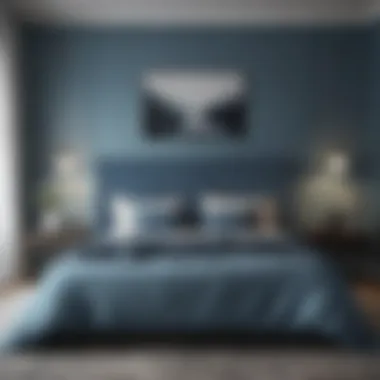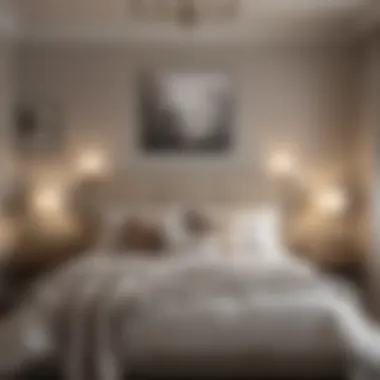Beautiful Bedroom Colors: A Guide to Creating Your Ideal Space


Intro
The choice of color in bedroom design is not merely an aesthetic consideration; it is a reflective decision that impacts emotions and well-being. The bedroom is a personal retreat, a space for rest and relaxation, and the colors selected can greatly influence your mood and the overall ambiance. In this article, we explore the significance of color selection in creating your ideal space, focusing on current trends, psychological effects, and practical tips for harmonious living.
Key Insights and Trends
Current Trends in Interior Design
In recent years, there has been a shift toward creating serene environments in the bedroom. Soft, muted colors such as pastel blues, greens, and grays are becoming increasingly popular. These hues not only produce a calming atmosphere but also reflect a desire for simplicity and tranquility in our hectic lives.
Another notable trend is the use of bold accent colors. Deep shades like navy, emerald green, or even rich burgundy can serve as a counterpoint to softer wall colors, providing depth and character. Layering different shades can create a visually interesting yet peaceful environment.
Psychological Effects of Colors
Colors have profound effects on our emotions. For example, blue is often associated with calmness and stability, making it an excellent choice for a bedroom. On the other hand, warmer colors like yellow can evoke feelings of cheerfulness and energy, which may not always be desirable in a space intended for rest. Understanding the psychological implications of color can guide you in making better choices.
"Choosing the right color is more than just trends; it’s about creating a space that resonates with you personally."
Practical Tips and How-To Guides
Step-by-Step Guide for Painting Your Bedroom
When decorating your bedroom, consider the following steps:
- Choose Your Base Color: Start with a base color for walls. Think about how the color affects emotions.
- Select Accent Colors: Pick one or two accent colors for details like pillows, curtains, and artwork.
- Test Samples: Paint small swatches on your walls to see how they look during different times of day.
- Consider Lighting: Remember, lighting can change how colors appear on your walls. Natural light can be quite different from overhead or lamp lighting.
- Harmonize with Furnishings: Ensure that your color choices match with your current furniture and décor to create a cohesive look.
Additional Tips for Color Harmony
- Balance Warm and Cool Colors: Too much of either can throw off the room's energy.
- Incorporate Textures: Using various textures can enhance the appeal of your color choices.
- Accessorize Thoughtfully: When adding new elements to your bedroom, think about how they complement your chosen colors.
Creating your ideal bedroom space involves careful consideration of color choices. This not only contributes to the visual appeal but also ensures a positive emotional atmosphere.
The Importance of Color in Bedroom Design
Creating an inviting bedroom begins with selecting the right colors. Color influences how we feel and perceive a space. It affects mood, tranquility, and even sleep quality. Understanding the role of color in bedroom design can help homeowners create a sanctuary.
Color choice is not merely aesthetic; it holds the power to evoke emotional responses. Different colors can stimulate the mind, calm the spirit, or energize a space. This makes it essential to consider personal preferences alongside psychological impacts.
Choosing the right colors can lead to a more harmonious environment. It enhances personal style while ensuring comfort. Thus, understanding color's influence becomes foundational for any bedroom design.
Understanding Color Psychology
Color psychology is a field dedicated to how colors affect human emotions and behaviors. Colors communicate feelings. For instance, blue often symbolizes calmness and serenity. It promotes relaxation, making it a popular choice for bedrooms. Conversely, vibrant hues like red can evoke excitement. Such colors might be more suitable for social spaces rather than restful areas.
Color influences not just emotions but also physical reactions. Psychological studies reveal that certain shades can lower blood pressure or increase heart rates. This knowledge helps in making more informed choices. When planning a bedroom, consider how each color impacts mood and feelings. This way, the space can better serve its purpose as a retreat.
Emotional Responses to Bedroom Colors
The emotional responses to color can vary significantly among individuals. However, general trends exist, making some colors more effective for certain atmospheres. For example, soft shades like pastels often create a soothing atmosphere. They can help in promoting restful sleep and peacefulness.
In contrast, darker shades might invoke feelings of coziness but can feel oppressive if overused. Furthermore, neutral tones are frequently chosen for their versatility. They act as a comforting backdrop and can be paired with various accent colors.
"The choice of color can transform a bedroom into a true oasis of calm."
When designing a bedroom, think about your emotional needs. What do you want to feel in this space? Should it embody tranquility? Or perhaps, warmth and energy? Understanding the emotional responses to various shades allows for a more tailored approach to bedroom design. Proper selection can lead to a harmonious and restful environment.
Current Trends in Bedroom Color Schemes
The selection of colors for a bedroom is no longer a mere afterthought. It plays an essential role in establishing a personal sanctuary. Current trends in bedroom color schemes reflect a move towards creating spaces that prioritize both aesthetics and emotional well-being. Before diving into specific palettes, it is crucial to recognize how these trends influence our daily lives and environments.
In contemporary interior design, color schemes extend far beyond just a coat of paint. They involve navigating a range of emotional impacts, setting the right mood, and embodying personal style. By choosing colors that resonate well with the core essence of one’s character, homeowners create an inviting space that enhances relaxation and comfort. The trends highlighted in this section embody a mix of innovation and timeless styles that aim to meet diverse preferences without compromising tranquility.
Popular Color Palettes for Contemporary Bedrooms
Today’s most favored color palettes often fuse boldness with subtlety. Popular choices range from muted earth tones to vibrant jewel shades, allowing for personal expression while promoting a calming atmosphere. Some key palettes include:
- Serene Blues and Greens: These colors evoke a sense of calm. Soft blues create an expansive feel, while greens introduce a refreshing, natural quality.
- Warm Neutrals: Shades of beige, taupe, and greige offer versatility. They allow for more diverse accent colors without overwhelming the space.
- Moody Jewel Tones: Rich colors like deep teal, burgundy, and navy bring depth to the environment. Used thoughtfully, these hues make spaces visually striking yet comfortable.
- Pastel Variants: Soft tones such as lavender, blush, or mint create a light and airy feel. These colors are especially popular in spaces meant for relaxation.


It's worth noting that the impact of color can also vary based on the proportion used in the space. A large format wall painted in a serene blue can instill peace, while accents of a moody shade can spark creativity.
Timeless Classics vs. Modern Trends
When examining the dichotomy between timeless classics and modern trends in bedroom color schemes, a thoughtful approach is crucial. Timeless classics often stand the test of time, frequently rooted in consumer culture that embraces familiarity. Shades like soft whites, taupes, and gentle blues provide a reliable backdrop in most design approaches. They promote longevity and resale value while remaining neutral enough for individual embellishments.
On the other hand, modern trends lean toward expression and individuality. This is where palettes are used not just for beauty but for self-definition. Here, homeowners often opt for unique combinations that were previously considered unconventional. For example, pairing charcoal gray with blush or mint allows for a balance that both softens and sharpens the environment.
In summary, the contemporary approach encourages a blend of traditional color palettes with striking modernity. This union allows for a personal narrative that evolves with the changing dynamics of preferences and lifestyle.
"Color can be a decisive element in turning a bland space into an exceptional experience."
By recognizing current trends in color schemes, individuals can take informed steps toward creating a bedroom that not only reflects their personality but also supports their emotional and mental well-being.
Selecting the Perfect Color for Your Bedroom
Choosing the right color for your bedroom is a pivotal step in creating a personal sanctuary. Color influences mood, behavior, and cognitive function. In this section, we will explore factors that contribute to making a well-informed decision. Selecting the proper hue not only reflects your personal style but also shapes the overall ambiance of your space.
Factors to Consider in Your Choice
Room Size and Layout
The size and layout of your room play a significant role in color selection. Smaller spaces often benefit from lighter shades, which create an illusion of openness. On the other hand, larger rooms might accommodate darker colors without feeling cramped. An essential characteristic of room size is it reflects how the colors will amplify or diminish spatial perception.
- Lighter colors: these make a room feel bigger and airier.
- Darker colors: they can add warmth and intimacy to expansive spaces.
A unique aspect of this factor is how it interacts with furnishings. A well-sized bed or a bulky wardrobe can clash with bold colors in smaller rooms, leading to a chaotic look. Therefore, proportions must be balanced thoughtfully.
Natural Light and Its Effects
Natural light significantly alters how colors are perceived. Rooms filled with abundant light tend to support a broader range of hues. When considering your options, observe how colors appear throughout the day. One must pay attention to seasonal variations in light.
- Morning light tends to be cooler, while afternoon light can create warmer tones.
- South-facing rooms gain maximum light, thereby benefiting from deeper colors.
This aspect can have hidden advantages and disadvantages. For instance, a color that initially feels fresh in the morning can become overwhelming in the evening light. Therefore, testing colors at different times is crucial.
Personal Preferences and Style
Your individual taste and style should take precedence in any color selection process. The bedroom is a personal space where comfort reigns. This specific aspect revolves around what resonates with you, be it minimalist, bohemian, or traditional design.
Highlighting your preferences can lead to a cohesive design and, ultimately, satisfaction with your choice. A uniqueness of this factor is how a color can encapsulate your personality.
- Pastels can evoke calmness for some.
- Bold shades may invigorate others.
However, it's essential to avoid overly trendy colors unless you are ready to change your palette in the near future. Personal style should blend timelessness with personal expression.
Creating Mood Boards for Visualization
A mood board serves as a visual guide to streamline your color preferences. Including swatches of paint, fabric samples, and inspirational images allows you to experiment with combinations without committing to them physically.
- Gather materials like paint chip samples, wallpaper swatches, and images from magazines or online platforms.
- Arrange these elements to gauge how colors interact.
This exercise can clarify your vision and assist in making definitive choices regarding the overall color scheme of your bedroom. Moreover, it can help in balancing color combinations effectively.
Color Combinations: Harmonizing Shades
Color combinations play a crucial role in bedroom design. They influence the mood of the space and impact how the elements within the room interact with each other. By carefully selecting colors, homeowners can create a harmonious environment that is visually appealing and fosters relaxation.
Understanding how different colors work together can help in maximizing the aesthetic and emotional benefits of a bedroom. It is not just about personal taste; it is about creating an experience that is cohesive and tranquil. Color combinations can define the character of a room, making it feel either inviting or overwhelming.
Complementary vs. Analogous Colors
Complementary colors are pairs of colors that are located directly opposite each other on the color wheel. This means they enhance each other when paired together. For example, pairing blue with orange creates a vibrant contrast. This combination can inject energy and liveliness into a bedroom.
On the other hand, analogous colors are next to each other on the color wheel. They share a common hue and usually create a subtle harmony in the space. If you choose blue, green, and teal, it provides a calming effect, suitable for a relaxing bedroom atmosphere. Understanding these relationships helps to utilize colors more effectively in design.
Here are some ideas for using complementary and analogous colors:


- Creating contrasts: Use complementary colors in a bold statement piece, such as a feature wall.
- Laying a base: Start with a neutral backdrop and layer in analogous colors to create depth.
Balancing Bold and Neutral Tones
Incorporating bold colors into a bedroom can make a strong visual impact. Colors like deep red, navy blue, or vibrant green can add personality. However, balancing these bold tones with more neutral colors is essential to avoid overwhelming the senses. Neutral shades provide a grounding effect, making the space feel calmer.
A few strategies to achieve this include:
- Accent walls: A bold color on one wall with neutrals in the rest provides focus.
- Bedding and accessories: These can feature vivid colors without committing the entire space to them.
- Layering textures: Use neutral-colored furniture with bold decorative items or art to maintain harmony.
Balancing colors thoughtfully allows for room versatility. Different lighting throughout the day can change how colors appear, making a well-thought-out combination even more important.
The Role of Lighting in Color Perception
Lighting plays a crucial role in how we perceive colors in any space, particularly in the bedroom. This perception shifts depending on the presence and type of light in the room. Understanding the dynamics of lighting helps to optimize the selected colors for a harmonious and stylish environment. The way light interacts with color can enhance or diminish elements like warmth, depth, and vibrancy. Therefore, the effect of lighting should not be underestimated when designing a bedroom.
Natural Light Sources
Natural light is an essential factor in how colors appear. Sunlight varies throughout the day. Morning light often feels cooler, while late afternoon or evening light may take on a golden hue. The orientation of the room may influence these natural tones. For instance, a north-facing bedroom typically receives soft, diffused light, while a south-facing room benefits from bright, direct sunlight.
When considering your bedroom colors, observe how the natural light affects them. Choose shades that look appealing under the specific light conditions typical for that space. For example, cooler colors may seem more soothing in softer, natural light, while warmer colors might radiate energy and coziness during the peak sun hours.
A few tips for utilizing natural light:
- Position of Windows: Identify how much light enters and at what times.
- Window Treatments: Use sheer curtains to diffuse light if brightness is an issue.
- Color Reflection: Light colors reflect natural light and can make a small space appear larger.
Artificial Lighting Options
Artificial lighting is another layer that significantly affects color perception. Different types of light bulbs produce varying color temperatures, categorized as warm (yellowish) or cool (bluish). Additionally, layered lighting designs—the combination of ambient, task, and accent lighting—can bring depth and dimension to any color scheme.
When selecting bulbs, consider the following:
- Incandescent Bulbs: Emit a warm light that enhances yellows, reds, and earthy tones, making them ideal for cozy atmospheres.
- LED Bulbs: Available in various color temperatures, they can mimic daylight and provide bright, clear illumination.
- Fluorescent Bulbs: Often cooler and harsher in tone, potentially washing out softer shades.
Incorporating a mix of these lighting types can offer flexibility. By utilizing dimmers, you can adjust the mood and appearance of the colors throughout the day, tailoring the ambiance to suit different preferences.
"Lighting can transform a space, making it a critical part of any aesthetic decision."
Incorporating Colors into Bedroom Decor
Incorporating colors into bedroom decor is essential in establishing the desired mood and aesthetic of your personal space. Colors influence emotions and perceptions, serving not only as a design element but also as a framework for comfort and relaxation. When selecting colors for decor, consider how different shades can enhance the overall atmosphere of the room.
Color choices can transform a space and reflect individual style. It is important to harmonize shades across various decorative elements to create a cohesive look. Whether it’s the bedding, curtains, or rugs, ensuring that colors complement each other can enhance the sense of unity within the room.
Selecting Bedding, Curtains, and Rugs
Bedding, curtains, and rugs are significant components of bedroom decor that should not be overlooked. These elements not only add tactile comfort but also contribute to the visual landscape of the room. When selecting bedding, opt for colors and patterns that either tie together your overall design theme or serve as focal points.
- Bedding: Choose colors that promote restfulness, such as soft blues or muted greens, which can soothe the senses. Alternatively, bold patterns can create dynamic energy. Consider the materials, too, as textures can affect color appearance in different lighting.
- Curtains: The curtain choice plays a crucial role in color application. Lighter curtains can make a small room feel larger, while darker tones can provide a cozy feeling. Fabrics that let in light while providing some privacy can enhance the room’s ambiance.
- Rugs: Rugs can tie a room together, grounding the color scheme. Select rugs that incorporate colors from other areas of the room, ensuring a seamless transition.
Art and Accessories: Adding Personal Touches
Art and accessories present opportunities to express personal style and enrich the color palette of the bedroom. The choice of art can echo the main color scheme or introduce contrasting hues that bring character to the space.
- Artwork: When selecting pieces, consider sizes and colors that work within the context of your decor. It can be advantageous to use art as a focal point—perhaps a large painting that introduces a bold color or theme.
- Accessories: Decorative pillows, vases, and other small items can offer bursts of color without overwhelming the space. These accents allow for simpler color choices in larger items while still providing visual interest.
Ultimately, combining colors thoughtfully within bedding, curtains, rugs, art, and accessories will help create an inviting and harmonious bedroom environment.
Common Color Mistakes to Avoid
Choosing colors for a bedroom can be daunting. Colors can profoundly affect mood, overall aesthetics, and comfort. However, many homeowners make mistakes that compromise the harmony of their space. Understanding these common pitfalls can save time, effort, and resources, leading to a successful and visually appealing bedroom design. By avoiding these common color mistakes, individuals can create an ideal environment that is both functional and pleasing to the eye.
Overly Themed Rooms
A mistake often observed in bedroom design is over-reliance on a single theme. While it's natural to draw inspiration from a particular style, such as bohemian or minimalism, taking this too far can lead to an uninviting and chaotic atmosphere. For example, using themed bedding, curtains, and artwork together can overwhelm the senses. Instead, aim for a balance where the theme is subtle. Incorporate colors that reflect the theme without dominating the space. This may mean choosing a few standout pieces rather than everything matching perfectly.
"A well-designed bedroom should reflect personal style but remain adaptable over time."


To avoid creating an overly themed room, consider these tips:
- Limit the use of theme-based elements. Choose a few items to highlight the theme.
- Integrate neutral colors with themed hues. This helps to ground the space and offers balance.
- Incorporate personal touches that may not follow the theme strictly. This can create character while maintaining cohesion.
Ignoring the Impact of Color Over Time
Another vital mistake is neglecting to consider how color may change over time. Colors can shift due to factors like wear and tear, lighting changes, and even trends in home decor. Bright colors might not remain vibrant, while softer hues can fade or lose their charm. It is important to choose colors that not only look appealing at first glance but will also stand the test of time.
In making your selection, think about:
- Durability of Paint or Fabric: High-quality paints resist fading and wear. Fabrics should also be chosen for their longevity.
- Lighting Adjustments: Natural light can change how colors appear throughout the day. Consider how light interacts with your color choices over time.
- evolving design trends: What is stylish today may not be in a few years. Opt for colors that are classic but flexible, avoiding extremely trendy shades that may not age well.
Adopting a prudent approach towards color selection allows homeowners to enjoy their space without the constant need for updates.
Practical Tips for Color Application
Applying color in bedroom design is not just about picking a favorite hue. It involves a thoughtful approach that considers how colors interact with the space and affect mood. Effective application can transform a room, creating an environment that fosters relaxation and peace. Below are tips that are essential for any homeowner or interior design enthusiast to consider when implementing color in their bedrooms.
Testing Paint Samples
Before committing to a color, testing paint samples is crucial. This step allows you to see how a color looks in various lighting conditions throughout the day. It can be surprising how drastically a hue can change based on natural and artificial light.
- Choose a Variety of Shades - Select a few paint samples that closely match your vision. It might help to include a lighter and a darker version of your preferred shades.
- Apply Large Swatches - Instead of small patches, paint larger sections on the wall. This gives a more accurate representation of how the color will appear once applied.
- Observe at Different Times - Monitor how the color looks during morning, afternoon, and evening light. This will provide insight into how it interacts with the room’s changing light sources.
- Consider Surroundings - Look at furniture, textiles, and any decor that will remain in the room. The color should complement these elements to create a harmonious space.
Testing paint samples can save you from costly mistakes and ensure your chosen color resonates well in the overall design.
Using Color Swatches Effectively
Color swatches are essential tools for visualizing how colors can work together in your bedroom. They help make informed decisions by providing a tangible reference.
- Collect Multiple Swatches - Gather swatches from different paint brands. Ideally, use the same color family, but explore varying shades to find the perfect one. This can simplify narrowing down choices.
- Create a Color Scheme - Lay out the swatches together. Look for combinations that are appealing and cohesive. Play with different arrangements to see how they work together.
- Use Swatches in Context - Take your swatches to the bedroom and place them next to key pieces of furniture or on bedding. This provides context and helps ascertain if the colors match your vision for the space.
- Consider Scale - Remember that colors can appear different in large volumes. Swatches provide a small representation, but always consider how the colors will look when a wall is entirely painted.
Using color swatches effectively bridges your ideas with practical application. This ensures that the final result aligns with your expectations, enhancing the aesthetic quality of your bedroom.
Maintaining a Cohesive Aesthetic
Maintaining a cohesive aesthetic in bedroom design is crucial for creating a harmonious space that reflects your personal style. A well-thought-out color scheme can significantly enhance the overall atmosphere of the room, fostering a sense of unity and calm. When colors complement rather than clash, they create an environment that supports relaxation and comfort. This aesthetic consistency can also increase the room's visual appeal, making it more inviting and enjoyable.
Transitioning Between Connecting Spaces
When designing your bedroom, it's essential to consider how it transitions into connecting spaces. Whether it's an adjoining bathroom or a hallway, maintaining color harmony helps create a fluidity that is appealing. Use similar or complementary colors in these areas to ensure a smooth flow. For instance, if the bedroom walls are painted a soft blue, consider using a lighter shade of that blue in the hallway. This approach does not only enhance the visual coherence but also creates a tranquil journey from one space to the next.
Creating Flow with Color
Creating flow with color involves the strategic placement of hues to guide the eye throughout the space. This can be achieved by selecting a primary color for the bedroom and using it uniformly in accents throughout the room. For example, if you choose a calming green for your walls, you could incorporate that color in your bedding, curtains, or artwork. Neutral tones can serve as effective balancing fillers to prevent overwhelming the space with color.
"The right color selections not only beautify the room but also establish a mood that can invigorate or soothe, depending on your needs."
To sum up, a cohesive aesthetic is not just about colors matching; it's about creating an environment tailored to your personal taste and emotional well-being. As you select colors for your bedroom, pay close attention to how they interact with adjacent spaces and ensure continuity throughout. This thoughtful approach will help you assemble a peaceful haven conducive to relaxation.
Final Considerations Before Committing
Before settling on a color scheme for your bedroom, it is essential to take time to reflect on your specific needs and preferences. This step is often overlooked but holds considerable weight in ensuring your space feels personal and harmonious. A well-considered choice can transform your bedroom into a sanctuary that nurtures relaxation and encourages restful sleep.
Identifying the ideal color palette should involve more than just aesthetics; it should align with psychological effects, overall room purpose, and individual lifestyle. By carefully weighing these elements, you can navigate the plethora of options and select colors that resonate with you, ultimately influencing how you feel in your space.
It is also wise to think about durability and maintenance. Some colors may need more upkeep than others. Dark colors might show more dust and stains, while lighter shades may require frequent touch-ups. Combining personal appeal with practical considerations will lead to a more satisfying finish.
Reassessing Personal Needs and Preferences
In this phase, evaluate how you use your bedroom. Is it purely a space for rest, or do you also use it for work or hobbies? This assessment could impact your color choices. For example, calming blue shades may promote a sense of relaxation, while vibrant yellows could uplift the room's energy, making it versatile for different activities.
Take into account your existing decor and furniture. Your selected colors should mesh well with these elements, creating a cohesive aesthetic that feels deliberate rather than random.
Additionally, consider changes in your life that might influence your preferences. Major life events or shifts, such as a new job or family changes, may cause your tastes to evolve.
Seeking Professional Guidance
If you find the task daunting or unclear, consulting a professional can provide clarity. Interior designers have valuable expertise on color theory, room dynamics, and the latest trends.
Working with a designer can save you time and prevent costly mistakes. They often can see the potential in your space that you might overlook. They can recommend brands like Sherwin-Williams or Benjamin Moore, providing access to quality products that suit your vision.
Moreover, involve professionals in creating mood boards and color swatches to visualize your ideas better. They can introduce you to tools that allow iterative adjustments, ensuring that the final selection aligns perfectly with your aspirations.
In summary, approaching your color choices with thoughtful consideration and expert insight can result in a beautifully balanced bedroom that fulfills both functional and aesthetic needs.



